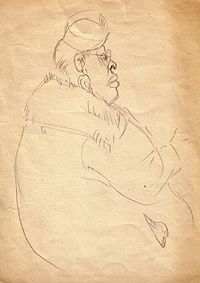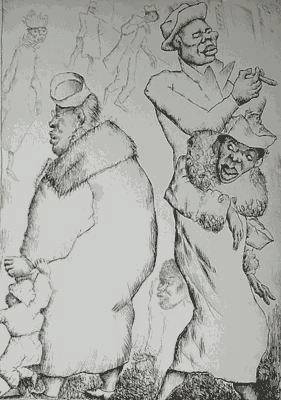|
Table of Contents
To navigate this catalogue raisonné, choose from the links below. |
|
Thumbnails, Part 4:
Prints made for Illustrated Books (These prints are not included in the catalogue raisonné proper.) |
|
A Biographical Chronology
of the artist (and its accompanying linked pages) appears on the website The Art and World of Luis Quintanilla |
|
To navigate
The Fiene Quintanilla Online Catalogue Raisonné Project, use the links below. |
| Useful Links |
| Quintanilla Copyright ©2006, Jeffrey Coven, CATRAIS Copyright ©2010 IA\TPC |
A Catalogue Raisonné
(in progress)
Title: Corner of Harlem*
Series: New York Prints ("Life in Manhattan")
Date: c.1938-1940**
Medium: Lithograph***
Edition: Currently Unknown (CU)****
Dimensions: 13 1/4 x 9 1/4 in. (34.3 x 22.8 cm)
Printer: (CU)
Paper: Wove
Signature: See below.*****
Public collections holding this print: (CU)
Topic galleries for this print:
1. New York City Scenes
2. Street Scenes
3. Studies of Men
4. Studies of Women
Notes
The proposed but never published book "Life in Manhattan" was intended to be Quintanilla's "poetic/artistic commentary on the myriad scenes" he encountered as he first experienced New York. The exiled artist arrived in the United States from facist Spain as the Spanish Civil War was ending and was fascinated by his new city, so different from Madrid and anything he had known in Europe (Quintanilla, Paul. Art and World of Luis Quintanilla).
As a precursor to this set of visual impressions of Manhattan, "the artist created at least 140 small sketches on scraps of paper," hasty studies performed as he wandered about the city. (To view a sampling of these sketches from Paul Quintanilla's website "The Art and World of Luis Quintanilla," please click here.) The only images actually intended for inclusion in the never published book are eleven lithographs, Corner of Harlem being one of them. To view thumbnails of all eleven lithographs, click here.
*Title and other annotations: At least one impression of each of the "Life in Manhattan" lithographs is titled in pencil (hand-printed), l.l. or l.c. (here lower left), just below the image. (See immediately below.) Although it is uncertain if these titles are in the artist's hand, they were undoubtedly known to him and are hence accepted as the titles of the lithographs for this catalogue raisonné.

**Date: The c.1940 dating for Quintanilla's "Life in Manhattan" lithographs is currently based on the date, 1940, inscribed on the Museum of Modern Art's impression of the lithograph, Museum of Modern Art, a print from this series. No other observed impressions from the series are dated, but as they were all created for the same project, the date of one can likely be attributed to the others.
***Medium: MoMA's catalogue entry for its impression of the Museum of Modern Art from this series says, "Lithograph printed from two zinc plates." Given the similarity of technique found in all of the "Life in Manhattan" series lithographs, it is likely they were all made in a similar fashion.
****Edition: Very little is known regarding an edition number for any of the lithographs from the "Life in Manhattan" series. One or two impressions of each image exist in the estate of the artist, while only a few impressions of lithographs from the series have been located outside of the estate.
*****Signature: Signed impressions from "Life in Manhattan" have rarely been observed; however, MoMA's impression of Museum of Modern Art as well as one other impression of that print bear a pencil signature. So do at least two impressions of Rockefeller Center and one of Washington Square.
 |
|
Pencil on paper (appr. 5 x 8 in.) These and othe early, New York scene sketches reflect Quintanilla's first impressions of the city shortly after he arrived in 1939 |
Setting: After Quintanilla's arrival in the United States in January, 1938, his friend the author Eliot Paul "introduced him to New York's glittering nightlife: to Harlem, the Stork Club, Cafe Society, and other popular watering holes . . . frequented by artists and writers." (Paul Quintanilla, Waiting at the Shore, Vol. 2, 13.)
